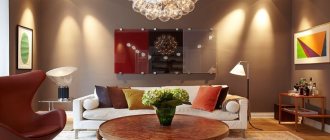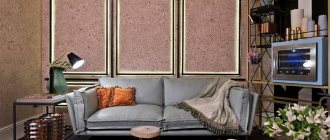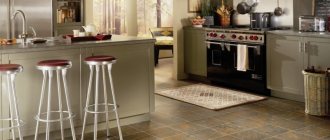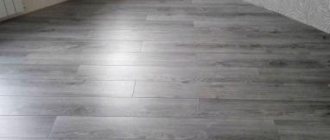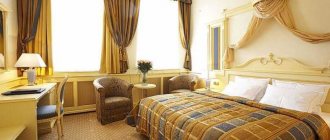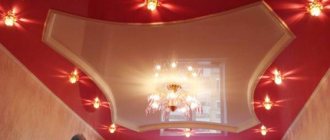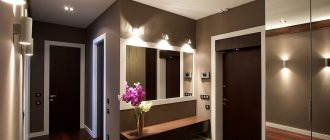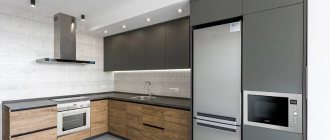Not so long ago, LED lamps were unheard of; then they began to be used only to illuminate certain areas of the room. Now LED lighting has become widely used and is actively used in most homes.
Basic moments
The attractiveness of LED lamps is obvious - the lighting creates a pleasant atmosphere; you can use single-color, colored LEDs, or combine different light sources. The use of LEDs in an apartment allows you to realize design ideas, give rooms an original look, and visually emphasize the advantages of the style.
Lighting using LEDs allows you to decorate walls, ceilings, floors, and highlight any functional area of the room. The products are easy to install, easily attached to the base surface, and you can install them yourself.
An important feature of LEDs is that the devices do not heat the surfaces they come into contact with or are in close proximity to, which eliminates the risk of fire.
Advantages and disadvantages of ice lamps
LED lighting devices appeared on the market relatively recently and quickly gained popularity among consumers. According to reviews, they have important advantages:
- Low energy consumption - a diode device at full power uses 70% less electricity than conventional light bulbs.
- Long service life - with proper calculation and development of the power supply circuit, the lighting operates for about one hundred thousand hours.
- High degree of resistance to damage - the devices are made of durable materials and do not have incandescent elements.
- No flickering effect – when using LED lamps, the voltage on the organs of vision is reduced.
- Minimal heating and heat release - thanks to low heat transfer, all energy is directed to lighting.
- Ease of installation - consumers can very easily install LED lamps with their own hands using glue and self-tapping screws.
Important! LEDs are compact in size, they are convenient to install in corners, niches, narrow openings, where the installation of chandeliers, shades and other products is excluded.
A significant disadvantage of LED light sources is their high price. Expensive, high-quality models cost from 2,000 rubles, budget options will cost from 90 rubles, but the latter, according to reviews, do not work for long. If one device fails, the LED network ceases to function. Since the LED is a semiconductor device, the brightness, power, and light intensity can be affected by the resistance of the conductor.
Types of LED lighting for apartments
Lighting an apartment with LED sources depends on several parameters: the dimensions of the room, interior features, visual zoning, the purpose of using artificial lighting. Based on these criteria, several types of lighting for ceilings, walls, furniture and interiors are distinguished.
Let's highlight the main types:
- Diffused artificial lighting. Acts as the main source of light radiation. The devices evenly fill the apartment with light, covering the entire area of the room. The main requirement for light is neutrality, the absence of unlit “spots” in the room, and calm radiation.
- LED work lighting. Used when zoning the interior space of a room. LED lamps are placed in functional areas where brighter, precisely directed light is required. This could be a work area near the desk, illumination of the area for cooking and eating, or the area around the mirror.
- Accent lighting when developing apartment design. Emphasis is drawing attention to a certain object, fragment, or area of the room. Light sources are positioned so as to visually illuminate paintings, figurines, bookshelves and other interior elements.
- Decorative lighting with LEDs. It does not perform a practical function, it is used to emphasize the aesthetic appeal of the apartment. Properly placed lighting and spotlights help to visually expand the boundaries of the room, complement and “revive” the atmosphere.
Types of lamps
Manufacturers of LED products produce lighting devices with different technical and operational characteristics. When choosing, you need to focus not only on the size of the lamps, but also on their type of glow and power.
There is no strict classification of LED lamps, but conditionally all devices can be divided into several broad groups:
- Based on the source used in the luminaire, a distinction is made between SMD LEDs with a long service life, COB - models of increased reliability with uniform light distribution, high-power and heavy-duty lighting products.
Related article: Lighting for a children's room: tips for organizing SMD LED
- Based on their application, LEDs for street and indoor lighting, industrial models, spotlights, and lamps for illuminating flowers are distinguished. In the apartment you can use any devices intended for indoor use.
LED lamp for illuminating flowers
- Based on the type of base, all LED lamps are divided into screw (E) and pin (G). Options for installation in an apartment: E27 - classic base with thread, E14 - base with reduced diameter, G5.3 - pin for lighting, G4, G9, G10 - backlight.
Different LED lamp bases
- LEDs differ in the shape of the lamp (round, candle, pear-shaped, oval), the presence/absence of a cooling radiator, brightness, color temperature (warm white, yellowish, neutral, cool white light).
Different types of lamps by shape
Important! When choosing an LED device, you need to pay attention to the product manufacturer. Lamps must be made from high-quality components.
Powerful LED lamp option
Life time
There is a concept of average service life for LED devices - 50,000 hours of continuous operation. Modern lighting technology has a complex design and many functional components.
Reliable manufacturers of diode lighting sources indicate in their characteristics that the service life corresponds to the generally accepted value L70 or LM70:
- a year of LED operation will be 9000 hours;
- Manufacturers set a full service life;
- the operation of the device is affected by fluctuations in the network;
- reduces operating time; low light output;
- The design of the LED light bulb plays a role.
Manufacturers of LED products indicate a warranty period of up to one or two years - lamps with a short and medium service life, from three to five years - high-quality LEDs, designed for up to 100,000 hours of operation.
Illumination of furniture and dressing rooms
In such furniture or a separate room, as a rule, it is impossible to install ordinary chandeliers or sconces, since they are quite massive. And spotlights make wardrobes and dressing rooms more functional, make it easier to find the necessary thing or item, including helping to maintain order on the shelves.
for ceiling Armstrong
Types of lighting fixtures
You can provide lighting in an apartment in different ways: highlight work areas, install main light sources, implement decorative and accent lighting for the room. Based on their purpose, dimensions, and installation method, there are several types of lighting devices with LED sources. Let's consider their features.
LED Strip Light
The design features of the tape device are a flexible board with diodes and conductive copper tracks. Each LED is enclosed in a housing.
LED strip lighting in an apartment has important advantages:
- Long service life;
- Minimum energy consumption;
- Flexible base, easy installation;
- Room lighting control;
- Compact dimensions of lighting equipment.
Strip lighting can be used in places where installing other lighting fixtures is impossible: the perimeter of the room, furniture parts, framing pictures, mirrors.
Chandeliers
Chandeliers powered by diodes are nothing more than LED ceiling lights. For apartments, pendant products with replaceable lamps are also used to organize basic or additional lighting in the room. The body of the chandeliers is made of metal, and the shades and lampshades are made of plastic, glass, or acrylic material.
Some models are equipped with remote controls, as in the photo below.
Advantages of LED chandeliers according to consumer reviews:
- large selection of shapes and sizes;
- light intensity control;
- installation on suspended ceilings;
- changing the color of the light flux;
- uniform illumination without flicker.
Ceiling chandeliers create a pleasant atmosphere and emphasize the artistic style of the room. In Moscow stores you can purchase LED ceiling chandeliers of exclusive design, which will occupy a central place in the interior.
Ice panels
A popular lighting option is LED panels installed in large rooms. A well-developed design allows the ceiling structures to harmoniously fit into the interior of the apartment. Based on the type of installation, panels are classified into built-in and overhead (suspended).
Products can have a round, rectangular, square shape. The thickness of the panels is 14-15 mm, so the lamps are convenient to use for apartments with low ceilings.
Also, such lighting equipment is produced with and without shades. For some models, control of brightness, color, and direction of lighting distributed by LED panels is provided.
Wireless lamp with motion sensor
In apartment lighting systems, wireless LEDs equipped with a motion sensor are used locally. The device reacts to the presence of a person, turns on, provides bright light in the illuminated area, and goes out after a certain time. The illumination range depends on the characteristics of the specific model.
Among the advantages of lighting technology are compact dimensions, light weight, easy installation, and bright light. When the sensor detects thermal radiation, the sensor reacts to movements and turns on the device if the room is dark.
Devices with a motion sensor can be installed with your own hands in the corridor, bathroom, toilet, hallway, dressing room. Wireless lamps are relevant for families with small children.
How to choose an LED chandelier?
Before purchasing the model you like, you need to consider some criteria. These include:
Room parameters. If the room has a large area, then it is recommended to choose large structures. The main task of such products is to fill the interior space with soft light as much as possible. For small rooms, the best solution would be to use miniature models of lighting fixtures.
Number of lampshades. The more lamps in the structure, the greater the versatility of this model. There may be multi-level backlights that will have a controlled mechanism.
Interior Design. Here you need to combine the chosen style and model of the LED chandelier. If the space is made in high-tech style, then there should be chrome elements and a fancy design.
If the interior is made in a classic style, then the optimal solution would be smooth lines and a beautiful design. The photo of LED chandeliers shows popular models that help decorate any interior.
External parameters of the chandelier. If the room has low ceilings, it is recommended to choose flat options. They will be located at the very top, thereby not creating visual pressure on the human subconscious. In spacious apartments, multilayer structures that have a laconic design are most often used.
The right LED lighting
In the interior space of the apartment, you can use spotlights, strip lighting, LED chandeliers, and create decorative lighting for individual interior items. Installation of products, characteristics of the power supply, and the choice of layout of light sources may differ depending on the room, the design of the devices and the installation location of the devices.
Article on the topic: Chandeliers in the interior of different styles: help in choosing (+130 photos)
The main rule for organizing apartment lighting is the harmonious arrangement of lamps, taking into account the dimensions of the room. For small rooms, small LED fixtures are installed, in medium-sized apartments you can use lamps of different designs, shapes and sizes, and in large rooms large lamps, chandeliers, sconces, floor lamps in combination with small accent details are appropriate.
Living room
The living room is the most spacious room in the apartment, which means there should be a lot of light here. Basically, a central light in the form of a chandelier is used in this room, but there are other options.
Three types of LED lighting are used in the hall:
- General - light sources are placed along the perimeter of the ceiling of the hall as in the photo below, the central place is occupied by a chandelier or panel.
- The work area - the relaxation area near the sofas and armchairs is illuminated with LED strips, sconces are installed near the coffee tables, and built-in wall lamps are installed in the ceiling.
- Decorative directional - used to frame interior fragments of the hall (niches in the wall, shelves, paintings, photos, mirrors).
In the living room, contour lighting around the perimeter of the ceiling using spotlights or LED strips looks advantageous, effectively emphasizing the beauty of tension, multi-level flows, making the room taller and more spacious.
Bedroom
Decorating a bedroom with lamps must be done carefully so that the lighting devices create a warm atmosphere, the light is not too bright or colored, and the intensity of the lighting does not interfere with rest and sleep. Main and additional light sources are installed in the bedroom. The ceiling contour is evenly illuminated with spotlights.
If the room is small, you can hang a small overhead or built-in LED chandelier in the center. The bedside area is decorated separately using special wall sconces and compact floor lamps. LED lighting under the bed looks beautiful and original.
If there is a painting above the head of the bed, the decorative element can be illuminated with an LED strip, or use decorative lighting for the mirror of the dressing table or wardrobe.
Children's
In the apartment, the children's room is designed taking into account the age and gender of the child, and the room is visually divided into several zones: play area, work area, sleeping area. The child should not experience a lack of lighting, so LED devices with bright, uniform light are installed in the nursery. The ceiling is decorated with a central chandelier or ice panel; spotlights can be installed around the perimeter.
In the nursery, it is necessary to provide directional lighting in the desk area using wall lamps and table lamps. By the bed or sofa, install a compact night light on the bedside table or mount an ice lamp on the wall.
In the play area, you can create original wall lighting using LED strips. It looks very beautiful and fabulous.
Kitchen
The interior space of the kitchen is usually small; there are several zones in the room that need to be well lit. General lighting is organized using compact built-in ceiling lamps or pendant chandeliers. In the work area (cooking area, stove, sink) there are bright LED lamps that give a cool glow.
Illumination of the tabletop and dining area
In the kitchen, it is important to use strip lighting, which can be installed in niches, corners, under glass, above shelves with dishes. Decorative lighting emphasizes the contours of the tabletop. There are options for tape in which the light sources are enclosed in an aluminum or plastic profile - harmoniously combined with the design of the furniture.
The dining area should be illuminated with bright, warm light. Hanging chandeliers located above the dining table are suitable for this.
In the video: DIY LED lighting for the kitchen work area.
Hallway
There are no sources of natural light in the apartment corridor; without quality lighting, the room will be dark. Several options for luminaire placement:
- In a narrow hallway, diodes are placed on the ceiling, directing light to the top of the walls to visually expand the corridor. For the same purposes, an LED strip is installed around the perimeter.
Related article: How to organize lighting in an apartment: diagrams and rules (installation of electrical wiring)
- In a room with a high ceiling, you need to focus on the walls, directing the light from the ceiling down.
- You can illuminate the corridor with groups of LEDs - symmetrical rows of spots along the perimeter, ice panels in the center, decorating the mirror with wall fixtures or tape for framing.
The main condition for lighting the hallway of an apartment is high power of light sources. When moving from room to room there should not be a sharp light contrast.
Bathroom
Installing a compact chandelier on the ceiling or spotlights in the bathroom will illuminate a small room well. Ice tape can be laid along the perimeter of the walls, around the bathtub - the light is well diffused and reflected from the ceiling, walls, and floor.
Additionally, you need to highlight the functional areas - bright lamps are mounted above the sink or symmetrically on the sides of the mirror.
Main types of lamps and scope of application
Device models are classified according to several criteria, taking into account the level of light emission power, resistance to temperature changes, and degree of strength. LED lamps have power from 3 to 280 W and even more. This allows you to choose the best option for lighting various rooms and objects. The volume of light emitted is measured in lumens, denoted as “lm”. The characteristics of each model indicate the minimum and maximum permissible air temperature, the degree of protection from dust and moisture. Depending on the color temperature, individual lamp models can emit warm or cool light.
Classification by type of installation:
- built-in;
- invoices.
Recessed luminaires are installed in plasterboard, plastic, tension and suspended structures. Overhead models are simply placed on walls, ceilings or in universal versions.
Classification according to installation location:
- ceiling;
- wall;
- floor, tabletop.
Ceiling devices are extremely easy to install. To work, you only need a knife, a screwdriver, an indicator and a screwdriver. Overhead lamps are perfect for rooms with low ceilings. Ceiling lighting fixtures have good power and perfectly diffuse light throughout the room. Wall-mounted devices have a more impressive and remarkable design than ceiling-mounted ones. They are often used as spot and additional lighting. Floor-standing models of LED lamps are produced in the form of beautiful floor lamps with elegant and subtle details. Floor-standing and table-top devices have a movable mechanism, thanks to which you can adjust the direction of light dispersion.
Case types:
- point;
- spotlights;
- ribbons;
- cascade;
- LED panels or bricks.
LED spotlights are installed in the interiors of apartments, houses and offices. They allow you to visually increase the height and area of the room. Spotlights are often used to illuminate facades, shop windows, signs, streets and various advertising structures. An LED strip is a flexible board on which LEDs are evenly spaced. Such devices are used for effective illumination of interiors, furniture, as lighting for advertising structures and as an addition to landscape design. Cascade models are suitable for installation in rooms with high ceilings and as a way of zoning space.
LED panels and bricks are quite large devices that are used to illuminate industrial premises, large shopping and entertainment centers, sports complexes, offices, offices, warehouses and streets. In most cases, housings are made of aluminum, stainless steel or plastic. Next, we will consider in more detail the types of LED lamps according to the type of their purpose.
Linear
Linear LED luminaires are designed as thin, oblong lamps that can be used as a primary or secondary lighting source. They can be easily installed on flat surfaces of walls, ceilings, and furniture. Installation is carried out using special fasteners or magnets, which are fixed to a metal base. In operation, linear lamps resemble long glow sticks; they can be positioned as desired; they can be recessed or surface-mounted. Thanks to the original linear design of the body, you can implement many interesting design ideas for effective interior lighting.
Linear luminaires can be touch-sensitive or modular. The level of illumination of touch models is controlled by light touches of the hands. Modular lamps are interconnected, so it is possible to build an original lighting system. Linear structures with an LED light source are located in any living room. Some models are resistant to moisture, so they can be used for bathroom and outdoor lighting. They are also installed in offices, supermarkets, educational institutions; they have a fairly wide range of applications.
Built-in
When installed, the body of recessed lamps is completely or partially hidden under the surface of the ceiling, wall, floor, or furniture. Based on the type of design, devices are divided into panel or modular, point-type, standard or furniture-mounted. They can create a diffuse or directional glow. Panel, modular lamps are produced in the form of square or rectangular boxes with a transparent plastic lid. Such devices have an industrial appearance, so they are often located in public spaces. They emit a directional glow, so that the room is illuminated evenly, it is necessary to install several panel boxes with LEDs.
Spotlights are also called downlights. In most cases, they are purchased for residential premises. Standard models are installed in plasterboard structures and are suitable for suspended and suspended ceilings. Spotlights with a more durable body can be built into floors and even street sidewalks. Certain models are used to illuminate furniture sets. You can purchase furniture with built-in LED lighting or buy special lamps separately and install them yourself. For mounting recessed luminaires, various bases are suitable, into which the body of the device can be deepened.
Wall mounted
Wall lamps can be recessed or overhead. Wall lighting devices are available in a wide range of different shapes and designs. For the living room, devices with round or square shades are suitable, which are combined with the overall interior design. For a child's room, it is better to choose devices with durable, closed shades. On sale you can find interesting stylistic solutions that will decorate the design of the room and appeal to the child. For the recreation area, lamps with a soft glow are more suitable, and for the play space it is worth choosing brighter sources.
In the hallway it will be enough to place several small spotlights on the walls. For the bathroom you need to choose models that are resistant to moisture. Using LED wall lights, you can highlight the work and dining areas in the kitchen. Above the desk in the office it is possible to create shadowless lighting using several spotlights. Devices with a built-in motion sensor will help reduce energy costs.
Industrial
LED industrial lamps are widely used for lighting production, warehouse and retail facilities. The versatility of industrial devices allows them to be installed in educational, administrative, and medical institutions and used as street lighting. Such artificial light sources tolerate unfavorable climatic conditions, high humidity, high vibrations and exposure to chemical fumes. LEDs are enclosed in durable, sealed, fireproof housings that can be mounted to the ceiling or mounted on pendant installations. Thanks to such devices, it became possible to create an optimal level of light intensity and intelligent lighting systems in production. LED devices do not contain harmful substances and do not emit ultraviolet radiation, so they are absolutely safe for people. They can be installed inside and outside various buildings.
Office
People spend a lot of time at work in offices. Therefore, it is important to provide optimal lighting that will have a positive impact on staff productivity. LED lamps distribute light that does not strain the eyes; when turned on, they light up immediately and do not flicker. In most cases, LED panels are installed in offices, in the shape of a rectangle, square or linear lamps. Also, the devices can be designer ones, which are specially selected for a certain interior style. Electric lighting sources are installed on ceilings, walls, floors and work tables, depending on the room parameters.
Street
LED devices for street lighting have increased resistance to adverse weather conditions, mechanical damage and reliable protection from dust, moisture and vibration. Technical characteristics allow them to be installed along roads, avenues, on poles, building facades, advertising stands and shop windows. With their help, architectural structures and areas near industrial, administrative, commercial, and medical institutions are illuminated at night. LED lighting sources are installed near the entrances of apartment buildings, in the courtyards of private houses and cottages.
Lamps for housing and communal services
In housing and communal services, LED lamps are installed in entrances, stairwells, basements and attics. Some models are equipped with additional protection against vandalism; the lamps are covered with metal grilles or shockproof shades. Devices with motion sensors, which turn on only when someone is on the staircase, are very popular. There are also devices that can be configured for a certain period of time. For example, when the lamps will turn on themselves when the object moves, but only from 7 pm to 6 am. This allows you to significantly reduce energy costs and extend the life of lighting devices for housing and communal services.
Spotlights
LED floodlights are widely used for night lighting in modern cities. The devices create bright, intense, directional light, while using a minimum of energy resources. The body of street floodlights is made of aluminum alloys and covered with a protective coating against corrosion. The device has a reflector that provides a uniform light flux with certain dispersion angles. Such devices have additional short circuit protection. The places where the wires are connected are covered with special protective tubes and insulating clamps, and the wiring is equipped with double insulation. LED floodlights have a wide range of applications in lighting street areas and objects.
Landscape
At night, your garden plot can look fabulous thanks to a well-organized lighting system. In landscape design, using LED lamps, beautiful lighting effects are created along paths, staircases, near trees, shrubs, flower beds, decorative sculptures, fountains, pools, ponds, gazebos and free-standing buildings. The design of landscape LED devices is quite laconic and simple. A beautiful visual effect is achieved not due to the decorative qualities of the lamps, but due to the successful arrangement of several light sources. To illuminate the area, built-in lamps or on brackets, as well as street spotlights can be used. In some cases, outdoor LED garlands become an effective addition to landscape design.
For pools, fountains and ponds
Previously, swimming pools, artificial reservoirs, waterfalls and fountains were illuminated only from the outside at night. Now it is possible to organize underwater lighting. For this purpose, special waterproof lamps and LED strips of different colors are produced. Models with the highest degree of energy protection - IP 68 - are suitable for installation underwater. For underwater lighting, surface-mounted or built-in devices with a sealed housing can be used. The deeper the waterproof luminaires are located, the higher their power level should be. For example, for decorative lighting of a swimming pool, it will be enough to install LED strips on its walls, slightly below the water level. And for deep reservoirs, lamps with a power of 15 to 20 W are suitable. Special controllers allow you to adjust the color and intensity of lighting.
LED lightening
Apartment renovation done in a modern style involves the installation of high-quality, durable lighting. All rooms must be provided with basic, additional, and optional decorative light sources. LED lamps can be used in different interior styles. For classic designs, warm, neutral light is appropriate, and in high-tech, high-tech, modern, fusion, and loft designs, diode sources of a cold glow look relevant.
Ceiling
The traditional way to install main lighting is to install the devices on the ceiling. Due to this, optimal distribution of light throughout the room is achieved, and niches, corners, and darkened areas are illuminated with additional sources.
Location of LEDs on ceiling structures:
- Installation in a plasterboard niche. The shape of the niche can be rectangular, square, curvilinear, oval. Drywall is mounted on the frame; wires can be hidden behind the sides of the structure. Chandeliers, spotlights, ice panels and LED strips are suitable for decoration.
- Illumination around the perimeter or contour. Wiring elements can be hidden behind the ceiling profile. LED strip and spotlights are used as lighting sources. The lighting should be directed towards the ceiling.
- Light patterns on the ceiling. The lighting elements (LED strip) are mounted to the base base, the spotlights are installed pointwise, and the tension structure is mounted. When the lights are off, the patterns are invisible, but when the LEDs are turned on, the room is transformed.
Professional designers often use LED lighting in interior projects to achieve the effect of a “floating” ceiling. Light sources are installed between the tension and base structures.
Stan
Decorative lighting of the walls gives the apartment an attractive look. Various designs and geometric patterns form a bizarre play of light and create soft reflections. Ice lighting of the walls expands the boundaries of the room and emphasizes the architectural elements of the interior. It is important that the intensity, brightness and color of the lighting can be adjusted. The proximity of light sources does not spoil the surface of the wallpaper and does not heat up the panels.
LED strip and linear ice lamps are energy-saving materials; using them to decorate walls is profitable and practical. The main areas of illumination are corners, niches, the perimeter of the upper part of the wall, and interior elements. Linear shapes and soft contours look impressive.
Paula
To make the room more spacious and weightless, use LEDs to illuminate the floor. Light source options: tape, flexible neon, tubes with duralight LEDs. Ice panels are used less often (spotwise, in separate islands in living rooms and kitchens). You can choose a standard solution or colored floor lighting around the perimeter of the room.
For small corridors, a flexible neon thread is suitable, laid along the contour of the room at the junction of the floor and the walls of the hallway.
The main features of a chandelier made of LED rings
If you are deciding whether LED ring chandeliers are right for you, then you should know about their pros and cons.
Advantages:
- High-quality lighting - modern LEDs provide soft, eye-pleasing light.
- Variety of design solutions. You can choose a chandelier with rings for any room, for any interior, and it will always look stylish and modern.
Ring chandelier in gold color - a stylish solution for a modern interior
- Remote control control. Most models have a control unit that allows you to remotely adjust the color of the light, brightness and other parameters.
- Saving. LEDs will last at least 50 thousand hours, and their energy consumption is 10 times less than that of conventional incandescent lamps.
- Safety. LED chandeliers do not contain mercury, phosphorus and other substances hazardous to the body. Such lighting devices do not heat up and are more resistant to mechanical damage than similar lamps.
Among the disadvantages, one can highlight only the relatively high cost, but the difference quickly pays off due to savings on electricity.
Interesting lighting ideas
Thanks to the simple installation of LED sources and the flexibility of the material, you can highlight any area or detail of the room with soft, bright or colored light.
Interesting options for using LEDs:
- Window space - hidden curtain lighting.
- Arches, doorways, niches - lamps along the contour.
- Illumination of a kitchen island, table or bar counter.
- Illumination of mirrors, bathtubs, plumbing fixtures.
- Illumination of the kitchen apron, the lower part of the wall cabinets.
LEDs can be used to decorate indoor plants, highlight ceiling niches, highlight an aquarium, and bookshelves. There are many ideas on how to use LED sources in apartment lighting. An important rule is that the main lighting should be uniform and bright, contour and decorative lighting should be accent lighting. There is no need for extra lighting sources in the apartment; it is enough to install several powerful devices and correctly direct the flow of light.
Installation of LED strip and 5 mistakes when choosing (1 video)
Ice lighting in the interior (55 photos)
Advantages of LED chandelier
The main positive quality of this device is its economical consumption of electrical energy. The bright illumination is several times greater than that of a conventional incandescent lamp. During operation, the chandelier does not heat up and does not generate heat.
The cost of diode lamps as part of the design is quite high, but their long service life allows them to compensate for these costs. With prolonged use of this chandelier, the color of the LED backlight and the tone of the radiation do not change.
If one of the elements of the chandelier has become unusable, you should not change all the other lamps. They automatically compensate for the absence of breakdown. In addition, these models have a fuse installed that protects the chandelier from changes in electrical energy.

